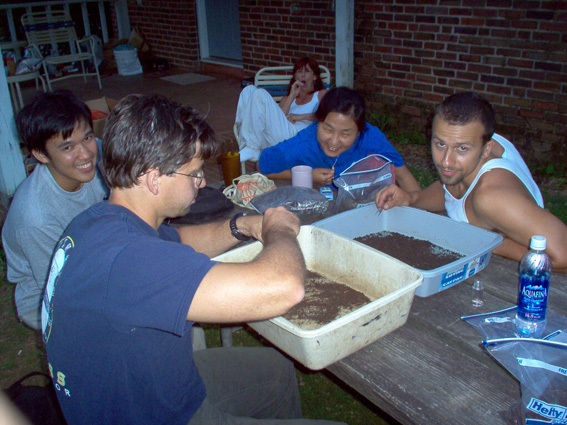Sifting Soil and Leaf Litter to Collect ArthropodsAuthor: Joe A. MacGown |
There are many species of ants, beetles, mites, micro-hymenoptera, diplurans, and other seldom collected arthropods that live in soil and leaf litter. The easiest way to collect these insects is to collect a portion of the soil and litter itself and then extract the insects from it by one of several methods, such as a Berlese funnel (a closed funnel system with a light source at the top, a screen to hold the sample in the middle, and a jar at the end of the funnel with 70-90% ethanol), Tulgren funnel (similar to a Berlese funnel, but much simpler), or Winkler sack (a variation on the Berlese funnel that doesn't require a light source). Alternatively, soil and litter samples can be spread out in a thin layer in a shallow pan and target arthropods can be visually signed and pulled out with forceps, fingers, or by other means. For collecting concentrated quantities of litter and soil, some type of sifter is recommended. Like just about everything else, there are many types of sifters available, from fancy folding bags made with tent material with round screens sewn inside them to a simple cat litter pan and sifting pan purchased from a local department store. I generally use a simple white cat litter pan with either a sifting tray that fits over the litter pan or a wooden tray with hardware screen. When collecting soil and litter samples, it is best if the soil is not overly wet, otherwise it is difficult to sift and is a mess in general. Typically, litter samples are made in forested areas where leaves may accumulate and decay layer by layer over a series of years. Samples can be made anywhere in those situations, but I usually look for areas of thick accumulations of litter, such as at the bases of large trees, beside rotting logs on the ground, or in slight depressions part way down a slope. Generally, I swipe back the topmost layer of leaves with a small garden shovel. I then remove the layer of humus/soil/litter found immmediately below and put it into the sifting pan. The litter and soil is then shaken back and forth, forcing the smaller particulate matter and insects into the bottom tray. When the soil and litter in the tray reaches the appropriate level, it is put into a gallon ziploc bag. Other people use cotton pillowcases, because it doesn't get as humid inside the bag and potentially kill the organisms before they can be extracted. I am mostly interented in collecting ants, which are much harder to kill, and have had no problem with temporarily storing the sample in the plastic ziploc bags. While in the woods collecting, the ziploc bags are placed inside a backpack, until they can be later placed inside of a cooler for transport back to the lab. At the lab, soil samples are placed into a Berlese funnel for several days until the sample is dried out and the insects have fallen into the jar of alcohol below.
|
 |
A "cat litter" pan with sifting pan. |
 |
Joe MacGown and JoVonn Hill sorting through litter and soil samples on a collecting trip, while other look on wishing they too had dirt to look through. |


